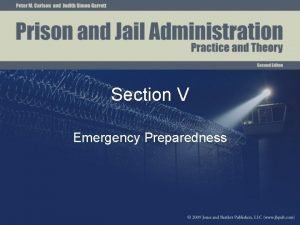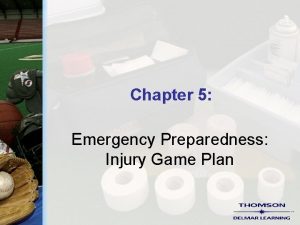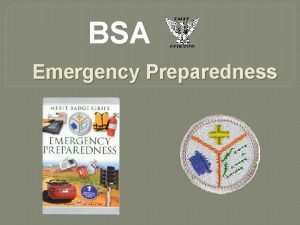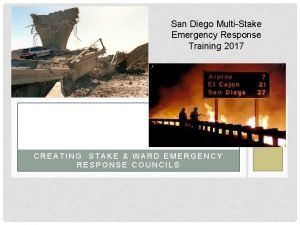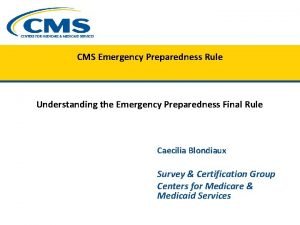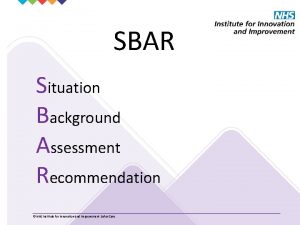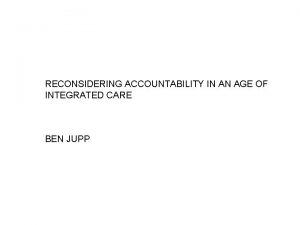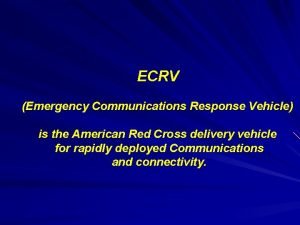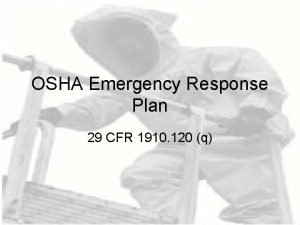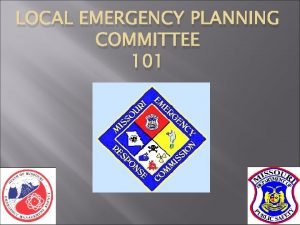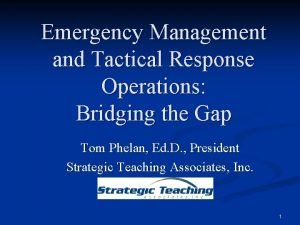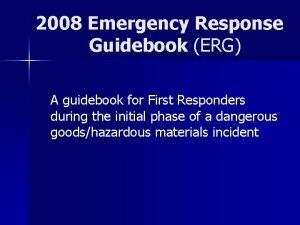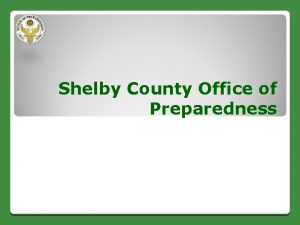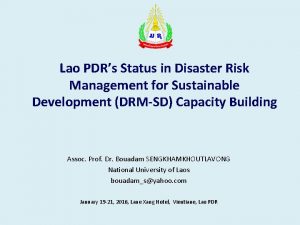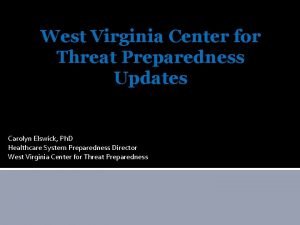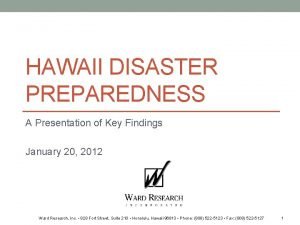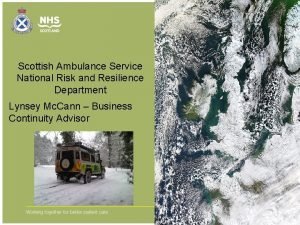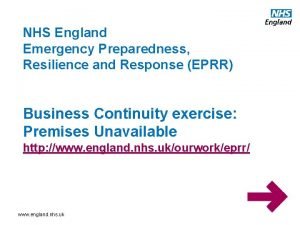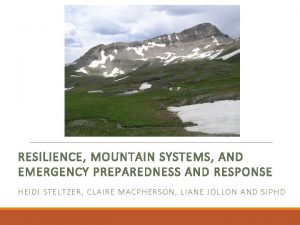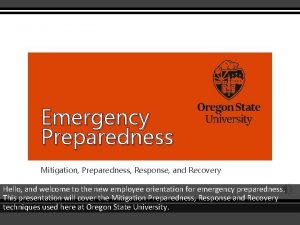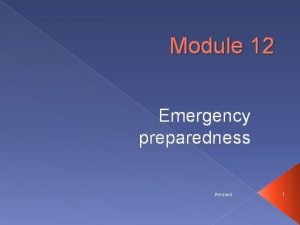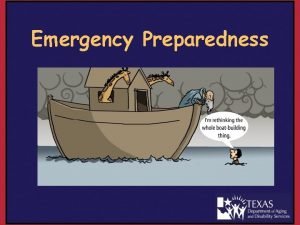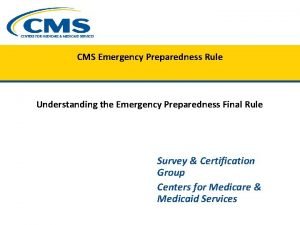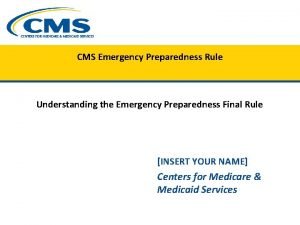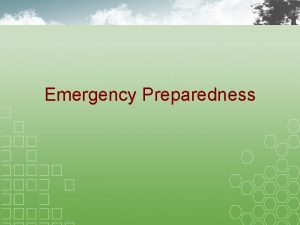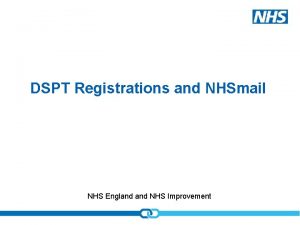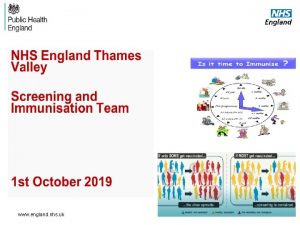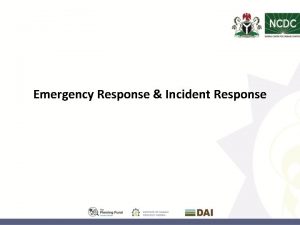NHS England Emergency Preparedness Resilience and Response EPRR




















































- Slides: 52

NHS England Emergency Preparedness, Resilience and Response (EPRR) Business Continuity Management NHS Workshop http: //www. england. nhs. uk/ourwork/eprr/ www. england. nhs. uk

Housekeeping • Fire safety • Breaks and refreshments • Toilets • Mobiles and IPad/ computers www. england. nhs. uk 2

Introduction • Respect each others contributions • What is said in the room stays in the room • Share your experiences to add value to the workshop activity www. england. nhs. uk 3

Course Objectives • To develop an understanding of Business Continuity • To understand how to use the toolkit • To understand how to undertake a business impact analysis for your organisation • To understand how to develop a business continuity plan for your organisation www. england. nhs. uk 4

Ice Breaker Tell the group: • Name • Role and department you work in • What role do you have in business continuity • Have you ever been involved in responding to a business continuity incident • Favourite sweet you had when you were growing up! www. england. nhs. uk 5

What is a Business Continuity? Is the capability of the organisation to continue delivery of products or services at acceptable predefined levels following a disruptive incident. (Source: ISO 22313/22301) www. england. nhs. uk 6 )

What is a Business Continuity Management System? ISO 22313/ 22301 (2012) A business continuity management system emphasises the importance of; • Understanding the organisations needs and the necessity for establishing business continuity management policy and objectives, • Implementing and operating controls and measures for managing an organisation’s overall capability to manage disruptive incidents, • Monitoring and reviewing the performance and effectiveness of BCMS, and • Continual improvement based on objective management www. england. nhs. uk 7

Elements of Business Continuity Management Business impact analysis and risk assessment Exercising and Testing www. england. nhs. uk Operational planning and control Establish and implement BC procedures Business Continuity Strategy/ Leadership ISO 22313 (2012)8

Plan Do Check Act Cycle The ISO 22301 and 22313 uses a ‘Plan-Do-Check-Act’ Cycle in planning, establishing, implementing, operating, monitoring, reviewing, maintaining and continually improving the effectiveness of an organisations Business Continuity Management System www. england. nhs. uk 9

Plan Do Check Act Cycle 2 www. england. nhs. uk ISO 22313 (2012) 10

Activity 1 In your groups discuss what the legal and/or regulatory responsibilities for Business Continuity are for your organisation and the wider NHS www. england. nhs. uk 11

Activity 1 - Summary • Civil Contingencies Act 2004 and Civil Contingencies Act 2004 (Contingency Planning) Regulations 2005 • ISO 22313: 2012 and ISO 22301: 2012 • NHS England Emergency Preparedness, Resilience and Response Guidance • NHS England Business Continuity Framework • Health and Safety at Work etc. Act 1974 • NHS Standard Contract 12 www. england. nhs. uk

Activity 1 – Summary continued Apart from the legal side – common sense prevails for the: • • 1 Public we serve The staff we employ Our partners we work with And those who commission our organisation www. england. nhs. uk

Interested Parties www. england. nhs. uk Adapted for the NHS from ISO 22313 14

Elements of Business Continuity Management 1 Business impact analysis and risk assessment Exercising and Testing www. england. nhs. uk Operational planning and control Establish and implement BC procedures Business Continuity Strategy ISO 22313 15

Business Impact Analysis Effective Business Continuity Management (BCM) starts with identifying all functions within and services delivered by the organisation. A business impact analysis (BIA) is the primary tool for gathering this information and then assigning each with a level of criticality. www. england. nhs. uk 16

Understanding the Organisation www. england. nhs. uk Adapted for the NHS from ISO 22313 17

Business Impact Analysis (BIA) Template • Risk assessment and treatment • Prioritisation of activities including Recovery Time Objectives (RTO) and Maximum Tolerable Period of Disruption (MTPD) • Identify resources required for maintenance of priority services 1 www. england. nhs. uk

Business Impact Analysis Activities that cannot tolerate any disruption Activities which can tolerate very short periods of disruption Activities which could be scaled down if necessary for short periods of time Activities which could be suspended if necessary Source: ISO 22313 1 www. england. nhs. uk

Activity 2 • In your groups: • Identify your organisations/departments essential activity/service • What are the resources required to deliver these? • Are there any apparent risks to maintaining these prioritised activities? • How will you reorganise to maintain these prioritised activities in the event of a disruptive incident? 2 www. england. nhs. uk

Elements of Business Continuity Management 2 Business impact analysis and risk assessment Exercising and Testing Operational planning and control Business Continuity Strategy Establish and implement BC procedures www. england. nhs. uk ISO 22313 21

Business Continuity Strategy Options Stakeholders Suppliers Information People Premises Technology Adapted from PAS 2015 www. england. nhs. uk 22

Activity 3 In your groups discuss: • Does your organisation have a business continuity strategy? • What do you think a business continuity strategy should contain and why? • Who is the organisation’s senior business continuity champion? • Does your organisation have an agreed essential service list? 2 www. england. nhs. uk

Activity 3 Summary • This is a senior management responsibility that: • Is appropriate to the organisation • Provides a framework for setting business continuity objectives • To continual improvement of the business continuity management system 2 www. england. nhs. uk

Elements of Business Continuity Management 3 Business impact analysis and risk assessment Exercising and Testing www. england. nhs. uk Operational planning and control Establish and implement BC procedures Business Continuity Strategy ISO 22313 25

Activity 4 Continuity Requirements People www. england. nhs. uk Premises Technology Information Suppliers and Partners 26

Activity 4 Continuity Requirements Complete People Premises Technology • What number of staff do you require to carry out critical activities? • What is the minimum staffing level you will need to deliver these • What skills/level of expertise are required to undertake these activities? • What locations do your prioritised activities operate from? • What alternative premises do you have? • What machinery, equipment and other facilities are essential? • Is the service dependant on electrical medical equipment? • What IT is essential to carry out your prioritised activities? • What systems and means of communication are required to carry out your prioritised activities www. england. nhs. uk Information • What Information is essential to carry out your prioritised activities? • How is this information stored? Suppliers and Partners • Who are your priority suppliers? • Are key services contracted out? • Do both you and your suppliers/ partners have mutual aid arrangements in please 27

Terms RTO – Recovery Time Objective Definition: period of time following an incident within which; product or service must be resumed, or activity must be resumed, or resources must be recovered NOTE: For products, services and activities, the recovery time objective must be less than the time it would take for the adverse impacts that would arise as a result of not providing a product/ service or performing an activity to become unacceptable. MTPD- Maximum Tolerable Period of Disruption Definition: time it would take for adverse impacts, which might arise as a result of not providing a product/service or performing an activity, to become unacceptable Source: ISO 22301 www. england. nhs. uk 28

Mitigating Impacts through effective Business Continuity: sudden disruption www. england. nhs. uk ISO 22313 29

Mitigating Impacts through effective Business Continuity: gradual disruption www. england. nhs. uk ISO 22313 30

Incident Timeline What mechanism could be used to ensure that during and following an incident the matter is escalated to the appropriate level in the organisation? What are your organisational command control arrangements? www. england. nhs. uk 31

Activity 5 List as many examples as you can of measures which could be considered in the context of flooding due to failure of internal plumbing systems to: 1. Reduce the likelihood of a disruption 2. Shorten any period of disruption 3. Limit the impact of a disruption www. england. nhs. uk 32

Example – NHS staff strikes • NHS staff strikes in 2013 and 2014 • Disputes over staff pay • The strikes were the first by NHS staff over pay in more than 30 years 3 3 www. england. nhs. uk

Example – Royal Marsden 2008 • More than 100 firefighters in 25 fire engines were deployed on the blaze • Between 80 -90 patients were helped onto the streets whilst the hospital was filled with thick smoke. • The fire could be seen across the London skyline. • Further information: http: //www. webarchive. org. uk/wayback/archive/20130304124 419/http: //www. london. nhs. uk/webfiles/Corporate/NHSL_FIRE _LR_2. pdf www. england. nhs. uk

Example – BT Flood and Fire March 2010 • • ‘. . . tens of thousands of customers in parts of North and West London may be experiencing a loss of broadband and/or telephone service [. . . ] as this is a complex incident we cannot accurately predict when all services will be restored. We will issue further updates as the situation changes. Any customers needing to make calls to the emergency services who have a problem using their phones are advised to do so by using their mobile phone, or alternatively by using a friend or neighbour's working phone www. england. nhs. uk

Example – Chase Farm Hospital 2010 • Loss of water supply due to burst water main in Enfield. • Bowsers (water tanks) are still on site to ensure the main patient areas continue to receive water [. . . ] Bottled water is available for staff and patients. • The A&E department is open to all walkin patients however all other emergencies are being transferred to Barnet Hospital. Once the water has resumed A&E services will return to normal. 3 6 www. england. nhs. uk

Activity 6: Business Continuity Strategy Options Discussion • Team work: • What strategies might be needed for maintaining core skills and knowledge? • What elements should your premises strategy consider to reduce the impact of the unavailability of one or more worksites? • What technology strategies for BC could your organisation adopt in the event of a disruption to the main area of your building following a fire, with an recovery time objective of 3 months? www. england. nhs. uk 37

Business Continuity Response Plans Organisations may have numerous plans. These may include: • Strategic organisational Incident Response Plan (IRP) • Department/service response plans • Building or site response plans • Technical response plans for IT or clinical systems www. england. nhs. uk 38

Business Continuity Incident Response Plan Content • • Document Control Purpose and Scope Document owner and maintainer Roles and responsibilities Plan activation Contact details Incident management structure and plan Action Cards www. england. nhs. uk 39

Business Continuity Incident Response Plan Content cont. • The plan should: • Set out the prioritised activities to be recovered, the timescales in which they are to be recovered and the recovery levels needed • Detail the resources available at different points in time to deliver the prioritised activities • Outline the process for mobilising the necessary resources • Include actions and tasks needed to ensure the continuity and recovery of prioritised activities • Be stored in a place that’s easily accessible for all…consider storing on a shared drive www. england. nhs. uk 40

Elements of Business Continuity Management 4 Business impact analysis and risk assessment Exercising and Testing www. england. nhs. uk Operational planning and control Establish and implement BC procedures Business Continuity Strategy ISO 22313 41

Exercising and Testing • Exercises are there to test plans to give an idea how our plans would stand up in a disruption • Ensures that plans are fit for purpose • Identify gaps and learning actions • Continuous updating of core information i. e. contact lists www. england. nhs. uk 42

Types of Business Continuity Exercises It is important for those who are responsible for Business Continuity to know which type of Business Continuity exercise is appropriate for what they wish to achieve before planning it. This is because exercises vary in levels and resources required. There are five main types of exercise and these are summarised below: 1. Discussion based exercise 2. Table top exercise 3. Command post exercise 4. Live exercise 5. Test www. england. nhs. uk 43

Why undertake a Business Continuity exercise? Exercises are undertaken with three main purposes: • Validation - to validate and identify improvement opportunities in existing arrangements • Training - to develop staff competencies and confidence by giving them practice in carrying out their roles in a incident • Testing - to test existing procedures, plans and systems to ensure they function correctly and offer the degree of protection expected www. england. nhs. uk 44

Business Continuity Off The Shelf Exercise Public Health England have developed a Business Continuity Off The Shelf Exercise (OTSE) which may be used by NHS England, Public Health England (PHE) and other key stakeholders as a tool with which to assess plans and preparedness. The Business Continuity OTSE uses three short scenarios to facilitate the review of local business continuity preparedness plans and enhance organisational resilience in case of disruption to the organisations core functions. To request an OTSE, please contact the Exercises Team: email at exercises@phe. gov. uk or call 01980 616928 www. england. nhs. uk 45

Embedding your Business Continuity Plan To embed business continuity within you must ensure that business continuity plans are: • communicated to staff, and • that those staff understand their roles and responsibilities. � 4 6 www. england. nhs. uk

Reviewing Business Continuity • Plans should be reviewed and updated when: • • Changes to key staff or partners take place The organisation is restructured Prioritised activity is delivered differently Change to the external environment e. g. statutory change, NHS England requirement • Following lessons identified from an incident or exercise www. england. nhs. uk 47

Maintaining Business Continuity A clearly defined and documented maintenance programme for the business continuity management should be established. This programme should: • Ensure that there is an on-going programme for business continuity training and awareness • ensure that any changes that impact on BC are reviewed • identify any new products and services, and their dependent activities that need to be included in the BCMS; • ensure that the business continuity plans remains effective, fitfor purpose and up-to-date; and • enable existing exercise schedules to be modified when there has been a significant change in any of the business continuity processes. 4 8 www. england. nhs. uk

Record Keeping Discussion When responding you need to keep records, but why is record keeping so important? www. england. nhs. uk 49

Record Keeping Discussion 2 ion t a m r o f al in Logs vit ent Documents d i c n i e h t t u o b a decisions made Docum ents a timeli of the ne incide nt Documents decisions not made and why Why is record keeping so important? Helps k eep about fi track nancial impact Details of casualties or near misses that occur Legal follow up www. england. nhs. uk n o i t a c uni m m d o e t c c s a r t fie Clari nels if pro chan incident 50

Questions www. england. nhs. uk

Next Steps…… www. england. nhs. uk
 Chapter 36 emergency preparedness and protective practices
Chapter 36 emergency preparedness and protective practices Chapter 36 emergency preparedness and protective practices
Chapter 36 emergency preparedness and protective practices Chapter 5 emergency preparedness injury game plan
Chapter 5 emergency preparedness injury game plan Bsa emergency preparedness
Bsa emergency preparedness National radiological emergency preparedness conference
National radiological emergency preparedness conference Stake emergency preparedness plan
Stake emergency preparedness plan Cms emergency preparedness requirements by provider type
Cms emergency preparedness requirements by provider type Preparedness mitigation response recovery
Preparedness mitigation response recovery Sbar nhs scotland
Sbar nhs scotland Mandy matthews nhs england
Mandy matthews nhs england Mandy matthews nhs england
Mandy matthews nhs england Ben jupp nhs england
Ben jupp nhs england Nhs england biosimilars
Nhs england biosimilars Contoh rencana tanggap darurat
Contoh rencana tanggap darurat Erg yellow section
Erg yellow section Objectives of reliance industries
Objectives of reliance industries Emergency communications response vehicle
Emergency communications response vehicle Cert sing
Cert sing Emergency response training services
Emergency response training services Utm emergency response plan
Utm emergency response plan 29 cfr 1910 120
29 cfr 1910 120 Missouri emergency response commission
Missouri emergency response commission Erg 2016
Erg 2016 Emergency disaster tactical response
Emergency disaster tactical response Erg blue section
Erg blue section Walmart emergency management
Walmart emergency management Emergency response plan
Emergency response plan Emergency response tool
Emergency response tool Purpose of disaster management
Purpose of disaster management Natural response and forced response
Natural response and forced response Natural response circuit
Natural response circuit Primary immune response and secondary immune response
Primary immune response and secondary immune response Learning that remains hidden until it is needed
Learning that remains hidden until it is needed Shelby county office of preparedness
Shelby county office of preparedness Insight learning theory
Insight learning theory Conditioning learning
Conditioning learning Conclusion for disaster management project for class 10
Conclusion for disaster management project for class 10 Biological preparedness
Biological preparedness Promoting family earthquake preparedness
Promoting family earthquake preparedness Data breach preparedness
Data breach preparedness Operant conditioning
Operant conditioning West virginia center for threat preparedness
West virginia center for threat preparedness Global pandemic preparedness
Global pandemic preparedness Nfpa 1600 standard
Nfpa 1600 standard Hawaii disaster preparedness
Hawaii disaster preparedness Nfpa business continuity
Nfpa business continuity Nc resilience and learning project
Nc resilience and learning project Social emotional assets and resilience scales pdf
Social emotional assets and resilience scales pdf Risk and resilience ambulance
Risk and resilience ambulance Pqa interview
Pqa interview Building grit and resilience
Building grit and resilience Resilience index measurement and analysis
Resilience index measurement and analysis Empathy and establishing trust with individuals
Empathy and establishing trust with individuals

